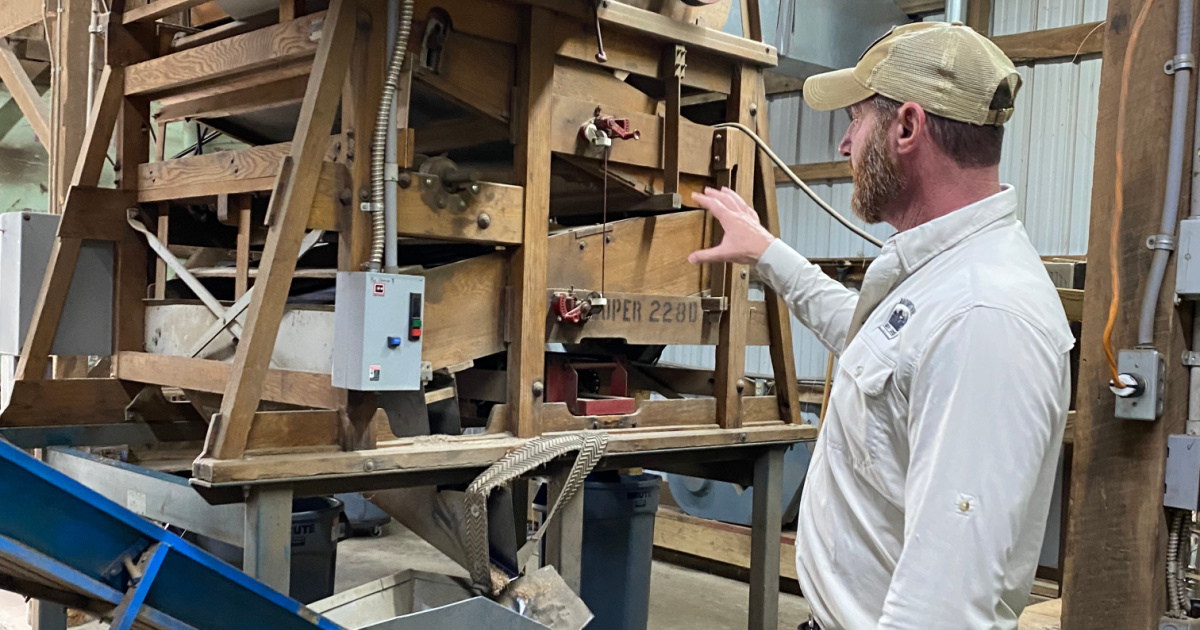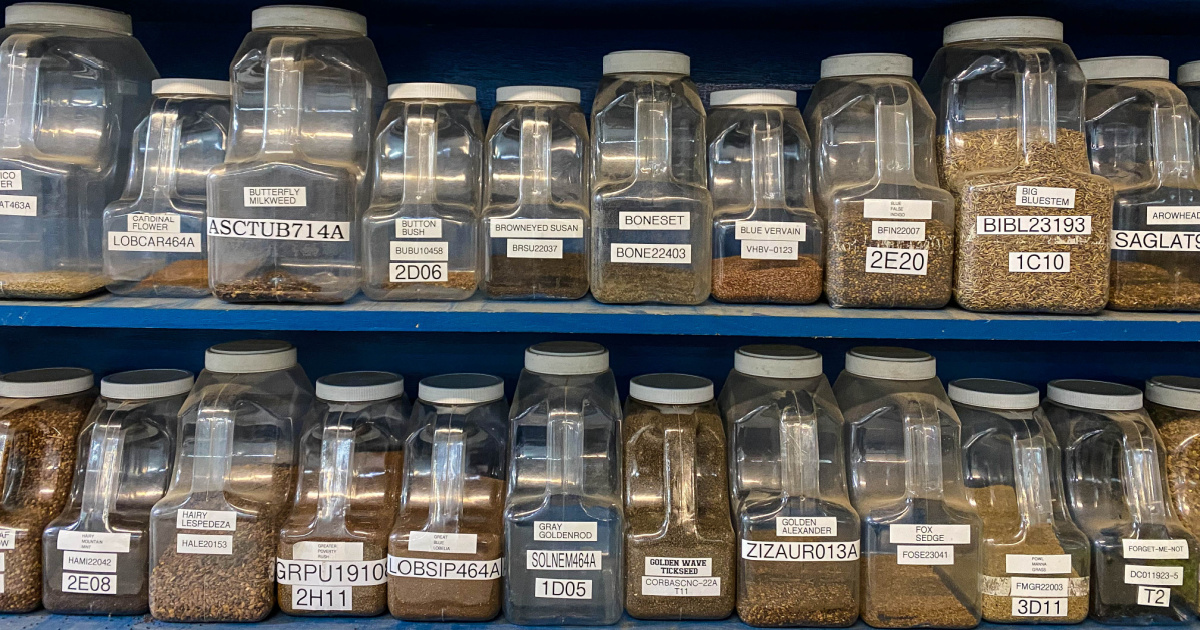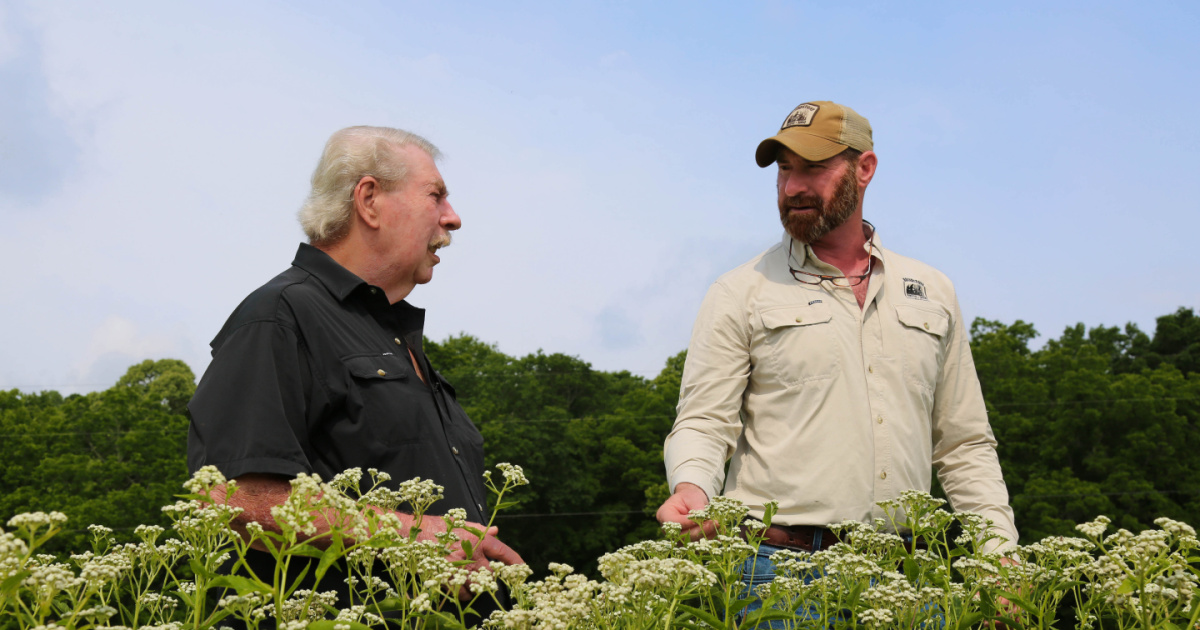Seeding Success
Posted on Sep 18, 2025Randy and John Seymour of Roundstone Native Seed earn the 2025 Kentucky Leopold Conservation Award for their dedication to environmental improvement
On a muggy summer day in northwestern Hart County, Kentucky, Randy and John Seymour inspect the delicate, flat-topped clusters of their wild quinine crop. Abuzz with pollinator activity, the abundant white buds reach hip height on the father-son duo. Rows of native blossoms extend through the field until they meet a dense forest edge, and idyllic birdsong fills the air at Roundstone Native Seed—the business they co-founded 32 years ago.
“It’s the most beautiful place in the world to me,” John says. “It’s a patchwork of color, a patchwork of grasses and blooms all different times of year.”
This pastoral land was added to the family’s farm acreage in the late 1970s, but the Seymours have been living and farming in Hart County for more than two centuries. The tract where Roundstone Native Seed sits was historically viewed as too hilly and rocky for agricultural use.
But this rugged land has been a blessing for the Seymours, whose passion for ecological restoration has bloomed into one of the largest and most well-respected native seed providers in the United States. Because much of the parcel was not friendly for traditional farming, the land was never plowed, thus leaving native plant species untouched. These plants were the seeds that, quite literally, started it all for Roundstone Native Seed.
What began as a small family business has ballooned into a bustling operation with more than 40 full-time employees. Today, Roundstone Native Seed raises about 3,500 acres and more than 280 species of plants native to the Eastern United States, including wildflowers, grasses, sedges, forage crops, and cover crops.
A deep-rooted passion
 The Seymours came from a family that relied on the land for food and homemade medicine and poultices. Randy’s love for wildflowers is imprinted in his earliest memories.
The Seymours came from a family that relied on the land for food and homemade medicine and poultices. Randy’s love for wildflowers is imprinted in his earliest memories.
“My mother—when I was little—took me out in the fields and showed me wildflowers,” Randy shared. “That was the beginning of my interest in botany.”
Later in life, Randy continued this tradition with his own son, John. They’d meander through the wilderness, and Randy would ask John to identify a plant species. They’d stay put until he got it.
“Growing up, it was always him talking about it and wanting to teach me,” John said. “And I don’t know that I had the yearning yet, at that young age, to be taught. I had other things on my mind. Later in life, it became my passion as well.”
Until the mid-’90s, the family farm primarily raised beef cattle, tobacco, hay, and timber. Just as the government began to pull support programs for tobacco farmers, John had coincidentally also developed an allergy to the crop.
“It was to the point that it was going to kill me. My last crop almost killed me,” John explained. “I would sweat green, and I would hallucinate and [experience] all the horrible things that happen to you with tobacco poisoning.”
The family was now searching for a way to diversify their operation.
Simultaneously, Randy had just wrapped up a passion project in the nearby Mammoth Cave wilderness, an area renowned for its diverse plant life. He’d spent two years canvassing every road and trail in the park, ultimately walking 900 miles to study, photograph, and document more than 400 wildflower species for his book, “Wildflowers of Mammoth Cave National Park” (published February 1997).
This book highlighted the diversity of plant life in the area, but it also highlighted a stark transformation from what would have naturally occurred on the land before European settlement, which brought with it a rapid depletion of forest and prairie land, soil erosion, and loss of wildlife.
At the same time, conservation programs, such as the Conservation Reserve Program (CRP) and Environmental Quality Incentives Program (EQIP), were on the rise, and Randy’s 58-page publication caught their interest. There was a demand for regional ecotype seeds, but no one was there to fill that demand. Thus, an idea was planted, and Roundstone Native Seed sprouted.
Cultivating success
The father and son pair started their business with a couple of five-gallon buckets, hand-picking seed from the native plants already growing on their property.
At first, things were tough.
“The reaction from our neighbors was…we were laughed at, scoffed at. You know, ‘What are they doing? Tobacco burning up in the field and these idiots are on the side of the road picking flowers.’ It wasn’t an easy transition,” John said.
 They were operating on a “shoe-string budget,” and when they needed new equipment, they had to get creative. With almost no funds to purchase what they needed, John went about repurposing and building his own custom seed sifters, sorters, and cleaners from whatever old, rundown wooden equipment they had available to them.
They were operating on a “shoe-string budget,” and when they needed new equipment, they had to get creative. With almost no funds to purchase what they needed, John went about repurposing and building his own custom seed sifters, sorters, and cleaners from whatever old, rundown wooden equipment they had available to them.
It took five years before the business turned a profit.
“Times were tough,” John said. “It’s hard to hold on when things are lean … If you can’t climb out, you just keep on digging. So, we just had faith, and thank the good Lord it’s finally turned around, and it’s turned into what it is, and I’m just really grateful to be where we’re at right now.”
Growing for the future
Today, Roundstone Native Seed is involved in restoration efforts in multiple states. They grow Kentucky native seed on their farm in central Kentucky and partner with producers in seven states to grow regional eco-type seeds there as well.
The Seymour family’s goal is to mimic nature and reestablish areas that have been changed beyond recognition. Examples of large-scale projects they work on include restoration around wetlands, streams, roadways, pipelines, powerlines, and military installations. They were contracted by Fort Knox to rewild the area surrounding tank ranges, where the soil turnover was 10-12 feet deep. Their partnership with the CRP helps turn fallow farmland into thriving ecosystems. They also work with farmers to identify and install beneficial cover, companion, and forage crops.
On a smaller scale, Roundstone Native Seed has seen a drastic uptick in individuals who are interested in creating backyard habitats.
“We became almost fashionable, I guess, with the products we had, particularly for the part of our society that did understand the need for wildlife and wildlife habitat plants and the need to keep the things that were near extirpation alive and going. I’m really pleased that the American public, at least from our standpoint, is taking to heart the importance of doing something to lessen the impacts of global warming.”
The Seymour family is responsible for thousands of beneficial native plantings across the eastern United States. And for that reason (and many others), John and Randy Seymour were recently named the winners of the Sand County Foundation’s 2025 Kentucky Leopold Conservation Award, which honors farmers and forestland owners who go above and beyond in their management of soil health, water quality, and wildlife habitat on working land.
“For us, this is the pinnacle of what we do,” John said. “Not only is it humbling, it is a great honor, and it makes you feel like what you’re doing is worthy, worthwhile, and that maybe somebody else sees it that way.”
Randy added, “I think that everybody needs to be told you’ve done a good job … This is the epitome of saying you’ve done a good job."
Tagged Post Topics Include: Kentucky Flowers, Kentucky Farm Bureau, Kentucky Leopold Conservation Award, Hart County, Roundstone Native Seed, John Seymour, Randy Seymour

Comments